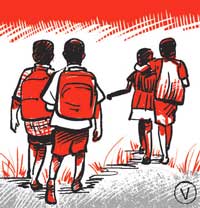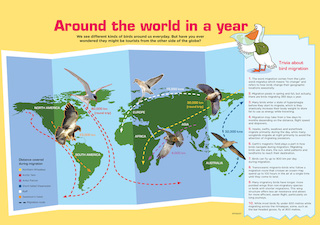Factory Schools: crimes against children from Survival International on Vimeo.
Two million tribal and indigenous children are in Factory Schools today. Lives are destroyed and families are torn apart as the children are intentionally alienated from their community and stripped of their identity.
Please watch, share and then join our campaign to stop #FactorySchools and help put indigenous education under indigenous control.
https://www.survivalinternational.org/about/factoryschools
All those children that are studying at KISS they are not able to learn our traditional way of farming. This is a very sad thing. The world depends on farming. They don’t know how to sow the seeds, nor the paddy. Nothing in our culture interests them anymore. The school leaves them half ignorant. They’re forgetting our values, farming, song and dances. Our vital traditions are being lost. They are bing ‘modernized’ […] They see us as inferior beings. – A tribal mother’s concerns, transcribed (accessed 28 March 2021)
Today around two million tribal children worldwide are being taught in Factory Schools, where they are stripped of their indigenous identity and indoctrinated to conform to the dominant society.
We’re on a mission to end Factory Schooling. Tribal and indigenous peoples’ education must be under their control; it must be rooted in the people’s own land, language and culture; and instil pride in themselves and their people.
Help us put indigenous education back under indigenous control. […]
Big corporations and extractive industries often sponsor Factory Schools. These companies want to profit from indigenous land, labor and resources, and Factory Schools are a cheap means to try to secure this in the long term.
Extractive industries in India and Mexico support schools which teach children to embrace mining, and to reject the connection their people have to their lands as “primitive.” States use schooling as a means of inculcating patriotism […]
Source: https://www.survivalinternational.org/factoryschools
Date visited: 30 June 2020
EMRSs [Eklavya Model Residential Schools] are a flagship intervention of the Ministry of Tribal Affairs to provide quality education to tribal students in remote tribal areas. The programme being implemented since 1998 have created a niche in the tribal education landscape of the country. However, the scheme was revamped in 2018 to improve the geographical outreach of the programme and introduce several qualitative changes to improve learning outcomes in the schools.
Currently there are 588 schools sanctioned across the country in 28 States/UT with around 73391 students enrolled in the Schools. Another 152 schools shall be sanctioned by the year 2022. Details of the schools can be seen on the dashboard of the Ministry available at www.dashboard.tribal.gov.in.
Source: “MoU signed with 21 States/UTs for better functioning of Eklavya Model Residential Schools”, Ministry of Tribal Affairs (PIB Delhi), 01 February 2021
URL: https://pib.gov.in/PressReleaseIframePage.aspx?PRID=1694272
Date Visited: 17 January 2022
[Bold typeface added above for emphasis]
Learn from M S Swaminathan – a world renowned scientist – how biological diversity contributes to public health, people’s livelihood and environmental security in addition to food security: his call on fellow citizens to use and share resources in a more sustainable and equitable manner; outlining the long journey from the 1992 Earth Summit to a commitment to foster inherited knowledge through India’s Biodiversity Act and Genome Saviour Award; an award intended to reward those who are “primary conservers” – guardians of biological diversity!
More about the work of his foundation which “aims to accelerate use of modern science and technology for agricultural and rural development to improve lives and livelihoods of communities.” – www.mssrf.org | Regarding the issues of food security raised above, and the nutritional value of indigenous grains, seeds and millets, read an in-depth report that concludes that “the tribal food basket has always been diverse and nutritious” >>
Up-to-date reports by Indian experts and journalists
Search tips
Combine the name of any particular state, language or region with that of any tribal (Adivasi) community.
Add keywords of special interest (health, nutrition endangered language, illegal mining, sacred grove); learn about the rights of Scheduled Tribes such as the “Forest Rights Act” (FRA); and the United Nations “Declaration on the Rights of Indigenous Peoples”, “Universal Declaration of Human Rights”, “women’s rights”, or “children’s right to education”.
Specify any other issue or news item you want to learn more about (biodiversity, bonded labour and human trafficking, climate change, ecology, economic development, ethnobotany, ethnomedicine, global warming, Himalayan tribe, hunter-gatherers in a particular region or state, prevention of rural poverty, water access).
For official figures include “scheduled tribe ST” along with a union state or region: e.g. “Chhattisgarh ST community”, “Scheduled tribe Tamil Nadu census”, “ST Kerala census”, “Particularly Vulnerable Tribal Group Jharkhand”, “PVTG Rajasthan”, “Adivasi ST Kerala”, “Adibasi ST West Bengal” etc.
In case the Google Custom Search window is not displayed here try the following: (1) toggle between “Reader” and regular viewing; (2) in your browser’s Security settings select “Enable JavaScript” | More tips >>
List of websites covered by this Google custom search engine
Academia.edu (platform for academics to share research papers) – www.academia.edu
Archive.org – https://archive.org
Centre for Science and Environment – https://www.cseindia.org
Current Conservation – https://www.currentconservation.org
Development and Cooperation (D+C) https://www.dandc.eu
Down To Earth (India) – www.downtoearth.org.in
India Environment Portal – www.indiaenvironmentportal.org.in
Harnessing Nature Magazine – https://harnessingnature.online
Mongabay-India – https://india.mongabay.com
M S Swaminathan Research Foundation – www.mssrf.org
Navdanya (protecting India’s biodiversity based food heritage) – https://navdanya.org
Third World Network (Penang, Malaysia) – https://twn.my
The Shola Trust (nature conservation in the Nilgiri region) – www.thesholatrust.org
Research the above issues with the help of Shodhganga: A reservoir of theses from universities all over India, made available under Open Access >>
Note: hyperlinks and quotes are meant for fact-checking and information purposes only | Disclaimer >>
Two Cheers for Democracy by E.M Foster in (London: Penguin Books 1976), p. 76
“If a man cannot enjoy the return of spring, why should he be happy in a labour-saving Utopia? … I think that by retaining one’s childhood love of such things as trees, fishes, butterflies and … toads, one makes a peaceful and decent future a little more probable, and that by preaching the doctrine that nothing is to be admired except steel and concrete, one merely makes it a little surer that human beings will have no outlet for their surplus energy except in hatred and leader worship.” – George Orwell
Residential, Ashram and Factory schools

- Ekalavya* Residential School Scheme (EMR): a network of boarding schools where tribal children are to be educated in accordance with rules and syllabi provided by the government; such schools are being designated as “Eklavya Model Residential School (EMR)” with the objective of empowering students “to be change agent, beginning in their school, in their homes, in their village and finally in a large context.” – Government Guidelines 2010 | Backup >>
- Residential School and Ashram School
In some regions there are similar “Residential Schools” and “Ashram Schools” for tribal children, as in Tripura where they are managed by a society called “Tripura Tribal Welfare Residential Educational Institutions Society (TTWREIS)” – Tribal Welfare Department, Government of Tripura - Factory schools “exist to turn tribal and indigenous children – who have their own language and culture – into compliant workers-of-the-future. The world’s largest Factory School stated that it turns ‘Tax consumers into tax payers, liabilities into assets’.” – survivalinternational.org/factoryschools | Learn more >>
Up-to-date information about these and related issues: Safe custom search engine >>
* Ekalavya (Eklavya, Eklabya): the name of a legendary archer prodigy “who, being a Nishada [Sanskrit Niṣāda, “tribal, hunter, mountaineer, degraded person, outcast”], had to give his thumb as a fee to the brahmin guru thus terminating his skill as an archer.” – Romila Thapar (“The epic of the Bharatas”) | Read the full paper here | Backup download link (pdf) >>
Note: “Forcibly transferring children of the group to another group” amounts to genocide, which the United Nations Office on Genocide Prevention defines as “acts committed with intent to destroy, in whole or in part, a national, ethnical, racial or religious group” (Article II, d & e)
Learn more about Childrens rights: UNICEF India | Ekalavya (Eklavya, Eklabya), EMR & Factory schools | Rights of Indigenous Peoples >>
For additional learning resources visit the website of the Centre for Science and Environment (CSE), “a public interest research and advocacy organisation based in New Delhi”:
Communication for Awareness
CSE’s publications and informational products have been its strength and they have always combined research and readability to get the message across.

CSE’s tools for awareness raising are periodicals, publications, films/short spots, briefing papers, exhibitions, posters and other products. CSE’s informational products reach people in more diverse ways such as features service, website and e-news bulletins. […]
Source: About CSE
URL: https://www.cseindia.org
Date Visited: 10 July 2022
Adivasi communities traditionally depended on the forest for all their nutritional needs. They subsisted mainly on fruits, vegetables, tubers, fish, small game as well as the occasional crop they grew, predominantly coarse grains. However, as time passed and the nature of, as well as their access to, forests changed, their diet started becoming deficient. […]
This deficiency started manifesting in the form of rampant malnutrition, among adults and children alike, underweight babies as well as high maternal mortality [and] increased susceptibility to Tuberculosis among the Adivasis.
Blog post “Gardening their way to Good Health” by ACCORD – Action for Community Organisation, Rehabilitation and Development (Accordweb, 14 March 2017) | Backup file:
Related posts
Biodiversity | Hyderabad biodiversity pledge
Climate change | Audio | The Climate Question (BBC Podcast)
Forest Rights Act (FRA) | Hunter-gatherers | Legal rights over forest land
Human Rights Commission (posts) | www.nhrc.nic.in (Government of India)
India’s Constitutional obligation to respect their cultural traditions
Misconceptions | “Casteism” and its effect on tribal communities
People’s Archive of Rural India (PARI) | RuralIndiaOnline.org
People’s Linguistic Survey of India | Volumes (PLSI)
United Nations on climate change >>
What is the Forest Rights Act about?
Who is a forest dweller under this law, and who gets rights?